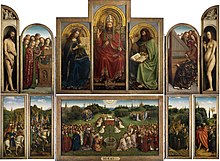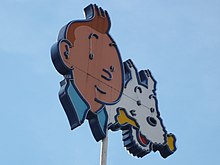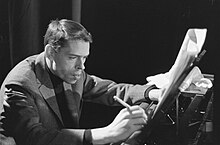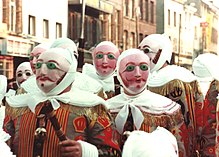Culture of Belgium


| Part of a series on the |
| Culture of Belgium |
|---|
 |
| History |
| People |
| Languages |
| Mythology and folklore |
| Cuisine |
| Religion |
| Art |
| Music |
| Sport |
The culture of Belgium involves both the aspects shared by all Belgians regardless of the language they speak and the differences between the main cultural communities: the Dutch-speaking Belgians (mostly Flemish) and the French-speaking Belgians (mostly Walloons and Brusselians). Most Belgians view their culture as an integral part of European culture.
The territory corresponding to present-day Belgium having always been located at the meeting point of Germanic and Latin Europe, it benefited from a rich cross-fertilization of cultures for centuries. Due to its strategic position in the heart of Europe, Belgium has been at the origin of many European artistic and cultural movements.
Famous elements of Belgian culture include gastronomy (Belgian beers, fries, chocolate, waffles, etc.), the comic strip tradition (Tintin, The Smurfs, Spirou & Fantasio, Marsupilami, Lucky Luke, etc.), painting and architecture (Mosan art, Early Netherlandish painting, the Flemish Renaissance, Baroque painting and Art Nouveau, as well as major examples of Romanesque, Gothic, Renaissance and Baroque architecture), folklore, and surrealism.
Since modern culture is more than ever related to languages (theatre, media, literature, etc), modern Belgian cultural life has tended to develop in each linguistic community (with common elements however). Members of each of the two main linguistic groups generally make their cultural choices from within their own language community, and then, when going beyond, the Flemish draw intensively from both English-speaking culture (which dominates sciences, professional life and most news media) and the Netherlands, whereas French-speakers tend to focus more on cultural life in France and elsewhere in the French-speaking world.
Minorities, such as the Jews who have formed a component of Belgian culture — in particular that of Antwerp — for over five hundred years, have some specific cultural aspects.
Art
[edit]Painting
[edit]
Belgium's contributions to painting have been especially rich. Mosan art, Early Netherlandish painting,[1] the Flemish Renaissance, and Baroque painting[2] are milestones in the history of art. While 15th-century art in the Low Countries is dominated by the religious paintings of Jan van Eyck and Rogier van der Weyden, the 16th century is characterised by a broader panel of styles such as Peter Brueghel's landscape paintings and Lambert Lombard's representation of the antique.[3] Though the Baroque style of Peter Paul Rubens and Anthony van Dyck flourished in the early 17th century in the Southern Netherlands,[4] it gradually declined thereafter.[5][6]
During the 19th and 20th centuries, many original romantic, expressionist and surrealist Belgian painters emerged, including James Ensor and other artists belonging to the Les XX group, Constant Permeke, Paul Delvaux and René Magritte. The avant-garde CoBrA movement appeared in the 1950s, while the sculptor Panamarenko remains a remarkable figure in contemporary art.[7][8] Multidisciplinary artists Jan Fabre, Wim Delvoye and the painter Luc Tuymans are other internationally renowned figures on the contemporary art scene.
Comics
[edit]
Belgium has numerous well-known cartoonists, such as Hergé (The Adventures of Tintin), Peyo (The Smurfs), Franquin (Spirou et Fantasio, Marsupilami, Gaston), Willy Vandersteen (Spike and Suzy), Morris (Lucky Luke), Edgar P. Jacobs (Blake and Mortimer), Jef Nys (Jommeke) and Marc Sleen (Nero).[9] More recently, Jean Van Hamme (XIII, Largo Winch, Thorgal, etc.), Raoul Cauvin (Les Tuniques Bleues, Agent 212), François Schuiten and Benoît Peeters (Les Cités Obscures) are among the most read cartoonists.
Belgium is home to some of the most important European comics magazines and publishers, with Dupuis (Spirou magazine), Le Lombard (Tintin magazine) and Casterman.
Museums
[edit]Some of the most impressive museums in Belgium are the Royal Museums of Fine Arts of Belgium in Brussels, which has a cinema, a concert hall and artworks of many periods, including a large René Magritte collection; the Royal Museum for Fine Arts in Antwerp, which has an admirable collection of works by Peter Paul Rubens; the Groeningemuseum in Bruges, with the Flemish Primitives; and the Museum aan de Stroom (MAS) in Antwerp, which is located on 't eilandje and is the biggest museum in Belgium.
Furthermore, the Plantin-Moretus Museum in Antwerp, a UNESCO World Heritage Site, is the complete factory of the largest 17th-century publishing house.[10]
Architecture
[edit]
Examples of Belgian architecture include the Romanesque Collegiate Church of St. Gertrude in Nivelles (1046) and the Cathedral of Our Lady in Tournai, the Gothic 15th-century Cathedral of Our Lady in Antwerp and the Baroque Grand-Place/Grote Markt (main square) in Brussels. Mosan style is typical of the architecture within the Prince-Bishopric of Liège.
Belgian contributions to architecture also continued into the 19th and 20th centuries, including the work of Victor Horta and Henry van de Velde, who were major initiators of the Art Nouveau style in Belgium and abroad.[11][12]
Literature
[edit]Belgium has produced several well-known authors, including the poets Emile Verhaeren, Guido Gezelle, Robert Goffin, Paul van Ostaijen, and Henri Michaux, as well as the novelists Hendrik Conscience, Stijn Streuvels, Charles de Coster, Willem Elsschot, Michel de Ghelderode, Georges Simenon, Louis Paul Boon, Suzanne Lilar, Hugo Claus, Pierre Mertens, Ernest Claes, and Amélie Nothomb. The poet and playwright Maurice Maeterlinck won the Nobel Prize in literature in 1911.
Belgian literature was more cohesive in the past but is now divided based on linguistic lines. Until the mid-20th century, Belgian writers more often wrote in French even if they were Flemish, due both to the then-dominant position of that language in worldwide culture as well as within Belgium itself (e.g. Suzanne Lilar, Emile Verhaeren, and Maurice Maeterlinck). As the Flemish movement grew in importance, Dutch-penned authors became increasingly prominent in Flanders and even played an important role in the said movement (e.g. Hendrik Conscience). Important contemporary Flemish authors are Tom Lanoye or Dimitri Verhulst.
Belgian francophone literature is sometimes difficult to distinguish from French literature as a whole, because several great French authors went to Belgium for refuge (e.g. Apollinaire, Baudelaire, Rimbaud, Verlaine, and more recently Eric-Emmanuel Schmitt) and conversely, top French-speaking writers sometimes settle in Paris (e.g. Simenon and Amélie Nothomb). Belgian francophone literature is characterised by authors who achieved a nationwide success in Belgium while being little known in France, and shares traits that are perceived as typically Belgian: use of black humour, self-derision, surrealism and absurdism (in a similar vein as Belgian painters such as René Magritte), as well as references to Belgian history and society (such as Belgian royalty, language conflicts, former colony of the Congo, Belgian beers and gastronomy, and whatever is typically Belgian) and they are often active in Belgian medias as columnists or entertainers. Such authors include Thomas Gunzig, Juan d'Oultremont, and Jacques Mercier.
There have also been writers in the Walloon language, such as Nicolas Defrecheux and Edouard Remouchamps.
Cinema
[edit]Belgian cinema has brought a number of mainly Flemish novels to life on-screen. Notable examples include De Witte (1934, remake as De Witte van Sichem, 1980); De man die zijn haar kort liet knippen (1965); Mira (1971); Malpertuis (1971); De loteling (1974); Dood van een non (1975); Pallieter (1976); De komst van Joachim Stiller (1976); De Leeuw van Vlaanderen (1985); and Daens (1992).
Belgian films have been awarded several times at the Cannes Film Festival and in other less-known festivals. They are generally made with a small budget, and are mostly funded by the regional governments (the Vlaams Audiovisueel Fonds, and Wallimage, among others) and private corporations by means of sponsorship and product placement.
Famous Belgian directors include André Delvaux, Stijn Coninx, Luc and Jean-Pierre Dardenne; well-known actors include Jean-Claude Van Damme, Jan Decleir and Marie Gillain; and successful films include Bullhead, Man Bites Dog and The Alzheimer Affair.[13]
Music
[edit]
The vocal music of the Franco-Flemish School developed in the southern part of the Low Countries and was an important contribution to Renaissance culture.[14] Many great medieval and Renaissance composers, such as Gilles Binchois, Orlande de Lassus, Guillaume Dufay, Heinrich Isaac, and Jacob Obrecht came from the area which is now Belgium.
In the 19th and 20th centuries, there was an emergence of major violinists, such as Henri Vieuxtemps, Eugène Ysaÿe and Arthur Grumiaux. Adolphe Sax, the inventor of the saxophone, was born in Belgium, and so were many important classical composers. One of the most famous is César Franck, but Guillaume Lekeu and Wim Mertens are also noteworthy.
Contemporary popular music in Belgium is also of repute. Well-known singers include Lara Fabian, Stromae, Jacques Brel, Angèle, Arno, Maurane, Bobbejaan Schoepen, Salvatore Adamo, Philippe Lafontaine and Pierre Rapsat. Other popular Belgian pop acts include Axelle Red, Vaya Con Dios, Kate Ryan and K3. In rock/pop music, Telex, Front 242, K's Choice, Hooverphonic, Zap Mama, Soulwax and dEUS are well known. In the heavy metal scene, bands like Machiavel, Channel Zero and Enthroned have a worldwide fan-base.[15] Belgium has a very active jazz scene that is achieving international recognition with bands like Aka Moon, Maak's Spirit and Octurn. Harmonicist Toots Thielemans, guitarist Philip Catherine and Django Reinhardt are probably the best known Belgian jazz musicians. Belgian hip-hop started with the rise of Starflam, CNN (a Brussels-based crew) and 't Hof van Commerce in the mid-1990s. The country has also influenced electronic music with a.o. Front 242, Praga Khan (also known as Lords of Acid) and 2 Many DJ's.
Belgium is also home to some very popular music festivals such as Tomorrowland, Rock Werchter and Pukkelpop.
Fashion
[edit]Belgium is also home to a number of successful fashion designers. For instance, in the 1980s, Antwerp's Royal Academy of Fine Arts produced important fashion trendsetters, known as the Antwerp Six.[16]
Cuisine
[edit]
Belgium is famous for beer, chocolate, waffles and French fries. The national dishes are "steak and fries", and "mussels with fries".[17][18][19][A] Many highly ranked Belgian restaurants can be found in the most influential restaurant guides, such as the Michelin Guide.[20] One of the many beers with high prestige is the ale produced by the Trappist monks. Traditionally each abbey's beer is served in its own glass (the forms, heights and widths are different). Six of the eleven breweries sanctioned to brew Trappist beer are Belgian.
Although Belgian gastronomy is connected to French cuisine, some recipes were reputedly invented there, such as French fries (despite the name, although their exact place of origin is uncertain), Flemish Stew (a beef stew with beer, mustard and bay laurel), speculaas (or speculoos in French, a sort of cinnamon and ginger-flavoured shortcrust biscuit), Brussels waffles (and their variant, Liège waffles), waterzooi (a broth made with chicken or fish, cream and vegetables), endive with bechamel sauce, Brussels sprouts, Belgian pralines (Belgium has some of the most renowned chocolate houses), charcuterie (deli meats) and Paling in 't groen (river eels in a sauce of green herbs).
Brands of Belgian chocolate and pralines, like Côte d'Or, Neuhaus, Leonidas and Godiva are famous, as well as independent producers such as Burie and Del Rey in Antwerp and Mary's in Brussels.[21] Belgium produces over 1100 varieties of beer.[22][23] The Trappist beer of the Abbey of Westvleteren has repeatedly been rated the world's best beer.[24][25][26] The biggest brewer in the world by volume is Anheuser-Busch InBev, based in Leuven.[27]
Folklore
[edit]
Folklore plays a major role in Belgium's cultural life; the country has a comparatively high number of processions, cavalcades, parades, ommegangs, ducasses,[B] kermesses, and other local festivals, nearly always with an originally religious or mythological background. The three-day Carnival of Binche, near Mons, with its famous Gilles (men dressed in high, plumed hats and bright costumes) is held just before Lent (the 40 days between Ash Wednesday and Easter). Together with the 'Processional Giants and Dragons' of Ath, Brussels, Dendermonde, Mechelen and Mons, it is recognised by UNESCO as a Masterpiece of the Oral and Intangible Heritage of Humanity.[28]
Other examples are the three-day Carnival of Aalst in February or March; the still very religious processions of the Holy Blood taking place in Bruges in May, the Virga Jesse procession held every seven years in Hasselt, the annual procession of Hanswijk in Mechelen, the 15 August festivities in Liège, and the Walloon festival in Namur. Originated in 1832 and revived in the 1960s, the Gentse Feesten (a music and theatre festival organised in Ghent around Belgian National Day, on 21 July) have become a modern tradition. Several of these festivals include sporting competitions, such as cycling, and many fall under the category of kermesses.
A major non-official holiday (which is however not an official public holiday) is Saint Nicholas Day (Dutch: Sinterklaas, French: la Saint-Nicolas), a festivity for children, and in Liège, for students.[29] It takes place each year on 6 December and is a sort of early Christmas. On the evening of 5 December, before going to bed, children put their shoes by the hearth with water or wine and a carrot for Saint Nicholas's horse or donkey. According to tradition, Saint Nicholas comes at night and travels down the chimney. He then takes the food and water or wine, leaves presents, goes back up, feeds his horse or donkey, and continues on his course. He also knows whether children have been good or bad. This holiday is especially loved by children in Belgium and the Netherlands. Dutch immigrants imported the tradition into the United States, where Saint Nicholas is now known as Santa Claus.
See also
[edit]Notes
[edit]- ^ Contrarily to what the text suggests, the season starts as early as July and lasts through April.
- ^ The Dutch word ommegang is here used in the sense of an entirely or mainly non-religious procession, or the non-religious part thereof—see also its article on the Dutch-language Wikipedia; the Processional Giants of Brussels, Dendermonde and Mechelen mentioned in this paragraph are part of each city's ommegang. The French word ducasse refers also to a procession; the mentioned Processional Giants of Ath and Mons are part of each city's ducasse.
References
[edit]This article needs additional citations for verification. (December 2008) |
- ^ "Low Countries, 1000–1400 AD". Timeline of Art History. Metropolitan Museum of Art. 2007. Archived from the original on 15 April 2007. Retrieved 10 May 2007.
- ^ "Low Countries, 1400–1600 AD". Timeline of Art History. Metropolitan Museum of Art. 2007. Archived from the original on 29 April 2007. Retrieved 10 May 2007.
- ^ Hendrick, Jacques (1987). La peinture au pays de Liège (in French). Liège: Editions du Perron. p. 24. ISBN 978-2-87114-026-9.
- ^ Guratzsch, Herwig (1979). Die große Zeit der niederländische Malerei (in German). Freiburg im Beisgau: Verlag Herder. p. 7.
- ^ "Low Countries, 1600–1800 AD". Timeline of Art History. Metropolitan Museum of Art. 2007. Archived from the original on 13 May 2007. Retrieved 10 May 2007.
- ^ "Art History: Flemish School: (1600–1800)—Artists: (biography & artworks)". World Wide Arts Resources. 5 February 2006. Archived from the original on 13 October 2009. Retrieved 10 May 2007.—A general presentation of the Flemish artistic movement with a list of its artists, linking to their biographies and artworks
- ^ "Belgian Artists: (biographies & artworks)". World Wide Arts Resources. 5 February 2006. Archived from the original on 15 May 2016. Retrieved 10 May 2007.—List of Belgian painters, linking to their biographies and artworks
- ^ Baudson, Michel (1996). "Panamarenko". Flammarion (Paris), quoted at presentation of the XXIII Bienal Internacional de São Paulo. Archived from the original on 7 February 2007. Retrieved 10 May 2007.
- ^ Grove, Laurence (2010). Comics in French: the European bande dessinée in context. Berghahn Books. ISBN 978-1-84545-588-0.
- ^ "Plantin-Moretus House-Workshops-Museum Complex". whc.unesco.org. UNESCO World Heritage Centre. Retrieved 1 June 2024.
- ^ Brussels, capital of Art Nouveau (page 1) Archived 9 May 2007 at the Wayback Machine, "(page 2)". Senses Art Nouveau Shop, Brussels. 2007. Archived from the original on 4 March 2007. Retrieved 11 May 2007. (for example)
- ^ "Major Town Houses of the Architect Victor Horta (Brussels)". UNESCO's World Heritage List. UNESCO. Archived from the original on 13 May 2013. Retrieved 16 May 2007.
The appearance of Art Nouveau in the closing years of the 19th century marked a decisive stage in the evolution of architecture, making possible subsequent developments, and the Town Houses of Victor Horta in Brussels bear exceptional witness to its radical new approach.
- ^ A review of the Belgian cinema till about 2000 can be found at"History of Cinema in Belgium". Film Birth. 2007. Archived from the original on 14 September 2011. Retrieved 26 June 2011.
- ^ "Western music, the Franco-Flemish school". Encyclopædia Britannica. 2007. Archived from the original on 8 December 2006. Retrieved 15 May 2007.
Most significant musically was the pervasive influence of musicians from the Low Countries, whose domination of the music scene during the last half of the 15th century is reflected in the period designations the Netherlands school and the Franco-Flemish school.
- ^ Two comprehensive discussions of rock and pop music in Belgium since the 1950s:
"The Timeline—A brief history of Belgian Pop Music". The Belgian Pop & Rock Archives. Flanders Music Centre, Brussels. March 2007. Archived from the original on 12 July 2007. Retrieved 7 June 2007.
"Belgian Culture—Rock". Vanberg & DeWulf Importing. 2006. Archived from the original on 7 June 2007. Retrieved 11 May 2007. - ^ "Fashion and the 'Antwerp Six'". Dorset, UK: Fashion Worlds. 2004. Archived from the original on 19 April 2007. Retrieved 13 May 2007.
- ^ "Steak-frites". Epicurious. 20 August 2004. Archived from the original on 8 August 2007. Retrieved 12 August 2007. Republished fromVan Waerebeek, Ruth; Robbins, Maria (October 1996). Everybody Eats Well in Belgium Cookbook. Workman Publishing. ISBN 978-1-56305-411-2.
- ^ "Belgium". Global Gourmet. Archived from the original on 28 September 2007. Retrieved 12 August 2007. Republished fromVan Waerebeek, Ruth; Robbins, Maria (October 1996). Everybody Eats Well in Belgium Cookbook. Workman Publishing. ISBN 978-1-56305-411-2.
- ^ "Mussels". Visit Belgium. Official Site of the Belgian Tourist Office in the Americas. 2005. Archived from the original on 10 February 2007. Retrieved 12 August 2007.
- ^ "The Michelin stars 2007 in Belgium". Resto.be TM Dreaminvest. 2007. Archived from the original on 9 October 2008. Retrieved 15 May 2007.
- ^ Elliott, Mark & Cole, Geert (2000). Belgium and Luxembourg. Lonely Planet. p. 53. ISBN 978-1-86450-245-9.
- ^ Snick, Chris (18 October 2011). "Nieuwe bierbijbel bundelt alle 1.132 Belgische bieren". Het Nieuwsblad (in Dutch). Archived from the original on 5 June 2012.
- ^ "Nieuwe bierbijbel met 1.132 Belgische bieren voorgesteld in Brugge". Krant van West-Vlaanderen (in Dutch). 18 October 2011. Archived from the original on 31 May 2012. Retrieved 17 February 2012.
- ^ Ames, Paul (30 August 2009). "Buying the World's Best Beer". Global Post. Archived from the original on 9 November 2010. Retrieved 19 November 2010.
- ^ Guthrie, Tyler (11 August 2010). "Day trip to the best beer in the world". Chicago Tribune. Archived from the original on 4 December 2010. Retrieved 19 November 2010.
- ^ "Monks run short of 'world's best' beer". ABC. Reuters. 12 August 2005. Archived from the original on 10 March 2009. Retrieved 19 November 2010.
- ^ "InBev dividend 2006: 0.72 euro per share—infobox: About InBev" (Press release). InBev. 24 April 2007. Archived from the original on 11 September 2007. Retrieved 31 May 2007.
InBev is a publicly traded company (Euronext: INB) based in Leuven, Belgium. The company's origins date back to 1366, and today it is the leading global brewer by volume.
- ^ "Processional Giants and Dragons in Belgium and France". UNESCO. Archived from the original on 27 April 2007. Retrieved 15 May 2007.
- ^ "Folklore estudiantin liégeois" (in French). University of Liège. Archived from the original on 20 June 2010. Retrieved 17 June 2008.
